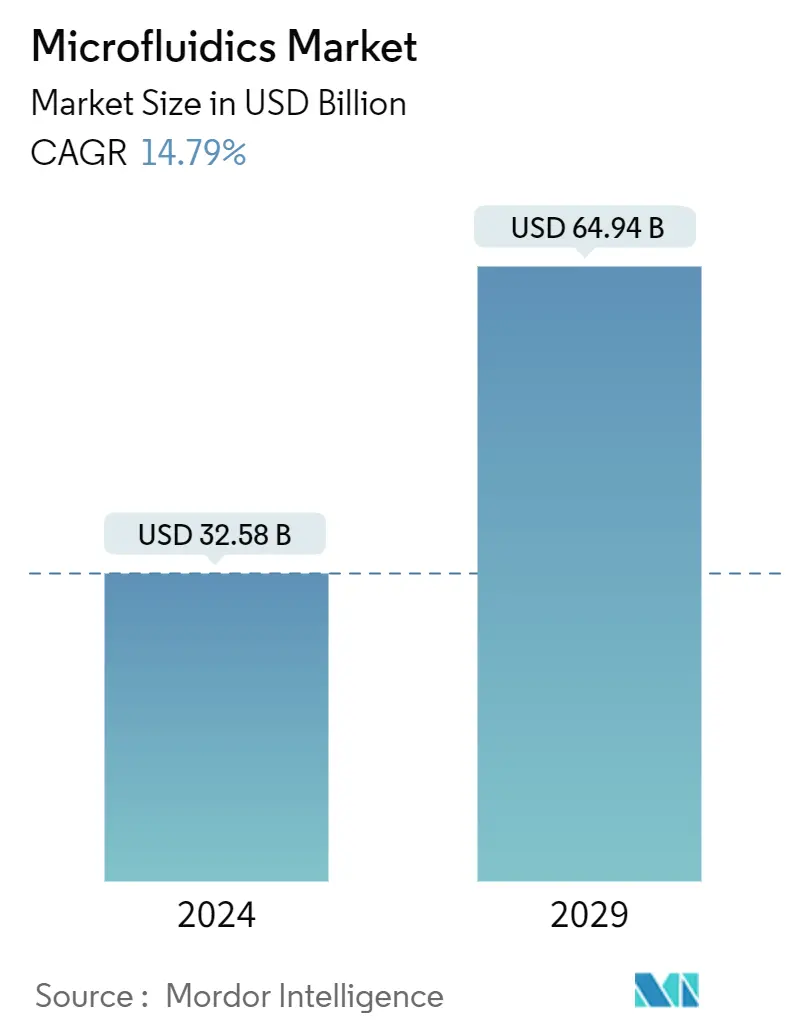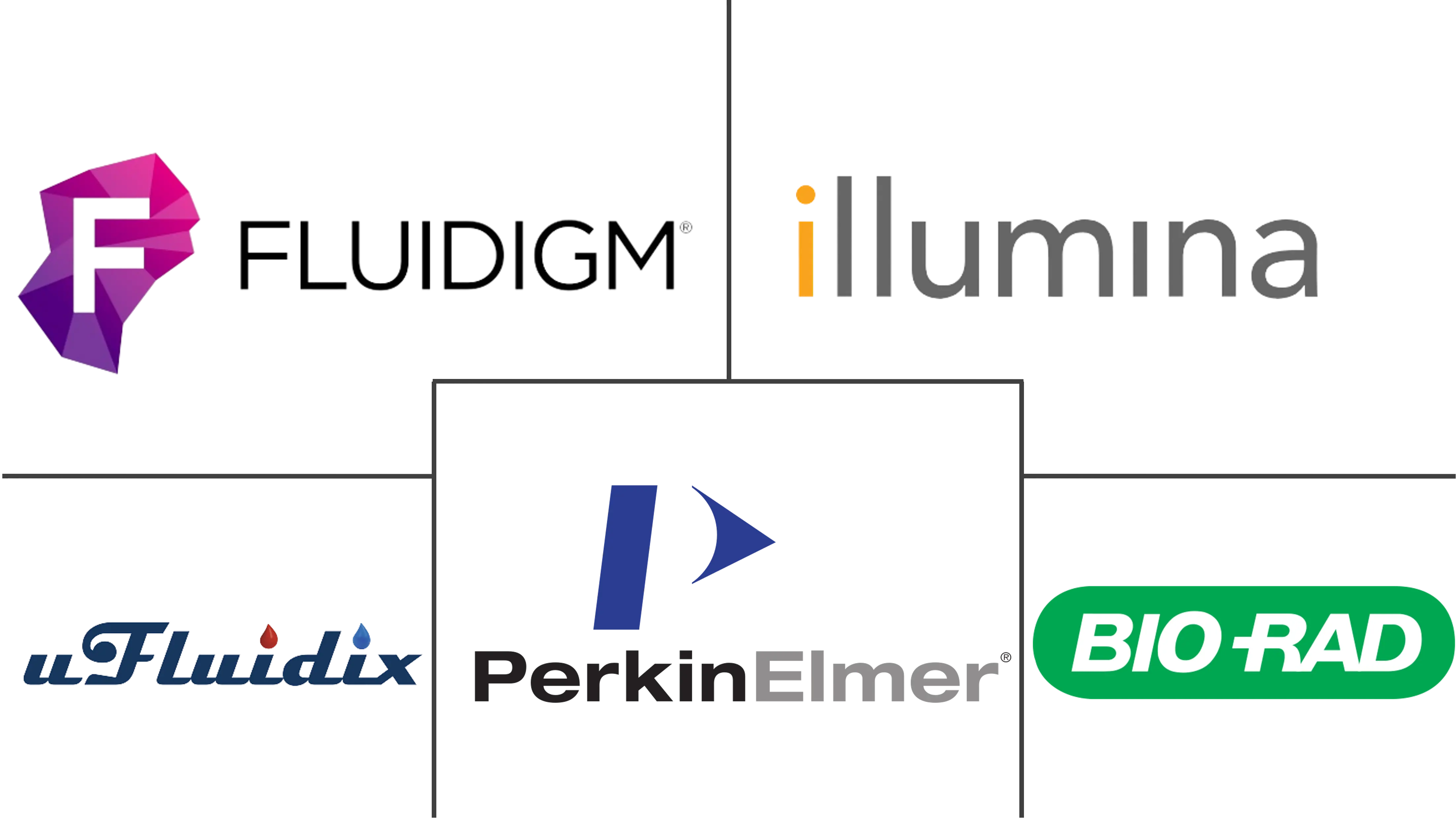Market Size of Microfluidics Industry

| Study Period | 2019 - 2029 |
| Market Size (2024) | USD 32.58 Billion |
| Market Size (2029) | USD 64.94 Billion |
| CAGR (2024 - 2029) | 14.79 % |
| Fastest Growing Market | Asia Pacific |
| Largest Market | North America |
Major Players
*Disclaimer: Major Players sorted in no particular order |
Microfluidics Market Analysis
The Microfluidics Market size is estimated at USD 32.58 billion in 2024, and is expected to reach USD 64.94 billion by 2029, growing at a CAGR of 14.79% during the forecast period (2024-2029).
The factors propelling the market's growth are the increasing demand for point-of-care testing, rising incidences of various diseases, the faster turnaround time for analysis, and improved device portability.
The rising burden of infectious diseases and chronic diseases such as cancer, diabetes, cardiovascular diseases, and others increases the demand for point-of-care testing, which is expected to propel the demand for the microfluidics market during the forecast period. For instance, according to the 2022 statistics published by the International Diabetes Federation (IDF), in Germany, about 6.1 million people lived with diabetes in 2021, projected to reach 6.5 million by 2030. Thus, the expected increase in the number of people with diabetes raises the need for novel porous microcapsules encapsulating β cells for diabetes treatment using microfluidic electrospray technology.
As cancer cases increase, the demand for advanced cancer therapy rises, expected to drive market growth during the forecast period. For instance, according to the data updated by the National Cancer Center of Japan, an estimated 1 million new cancer cases were diagnosed in Japan in 2023. Microfluidic devices mimic the cancer metastasis process and are usually applied to several cell types to culture two or more organoids. Thus, increasing cancer cases is expected to boost market growth during the forecast period.
According to the 2022 statistics published by Dementia Australia, 487,500 Australians lived with dementia in Australia in 2022, and this number is projected to reach about 1.1 million by 2058. Thus, the increasing burden of dementia among the target population raises the need for effective drug discovery, screening methods, and toxicology studies. This increases the demand for microfluidics systems that can be used to grow neurites, glial cells, endothelial cells, and skeletal muscle cells, along with the maintenance of fluid isolation, and provides an opportunity to investigate organogenesis and disease etiology.
The developments in microfluidics are also leading to the evolution of a cost-effective mass-production process for diagnostic devices. Smartphones paired with microfluidics enable the deployment of point-of-care testing. This has widened the application of microfluidic devices and is expected to expand.
The rising focus on developing microfluidics technologies and devices and the increasing adoption of various strategic initiatives are expected to drive the market's growth during the forecast period. For instance, in October 2022, Standard BioTools Inc. launched the X9 Real-Time PCR System, which uses microfluidics technology to provide a flexible and productive high-capacity genomics platform.
However, the integration of microfluidics technology with existing workflows and the low adoption in developing countries due to high prices are expected to hinder the market's growth during the forecast period.
Microfluidics Industry Segmentation
As per the scope of the report, microfluidics is a medical approach involving the precise control of small fluid samples for medical analysis. The sample sizes in microfluidics range from microliters to picoliters. At such low volumes, fluid transportation is governed significantly by its mass. The microfluidics market is segmented into product type, application, material, and geography. By product type, the market is segmented into microfluidic-based devices and microfluidic components. By microfluidic components, the market is segmented into microfluidic chips, micro pumps, microneedles, and other product types. By application, the market is segmented into drug delivery, point-of-care diagnostics, pharmaceutical and biotechnology research, clinical diagnostics, and other applications. By pharmaceutical and biotechnology research, the market is segmented into high-throughput screening, proteomics, genomics, cell-based assay, capillary electrophoresis, and other pharmaceutical and biotechnology research. By material, the market is segmented into polymer, silicone, glass, and other materials. By geography, the market is segmented into North America, Europe, Asia-Pacific, the Middle East and Africa, and South America. The report also covers the estimated market sizes and trends for 17 countries across major regions globally. The report offers the value (in USD) for the above segments.
| By Product Type | ||||||
| Microfluidic-based Devices | ||||||
|
| By Application | ||||||||
| Drug Delivery | ||||||||
| Point-of-care Diagnostics | ||||||||
| ||||||||
| Clinical Diagnostics | ||||||||
| Other Applications |
| By Material | |
| Polymer | |
| Silicone | |
| Glass | |
| Other Materials |
| By Geography | ||||||||
| ||||||||
| ||||||||
| ||||||||
| ||||||||
|
Microfluidics Market Size Summary
The microfluidics market is poised for significant expansion, driven by the increasing demand for point-of-care testing and the rising prevalence of chronic and infectious diseases. The technology's ability to provide rapid analysis and improved device portability is enhancing its adoption across various healthcare applications. The market is witnessing a surge in demand due to the growing need for advanced diagnostic and therapeutic solutions, particularly in the fields of cancer, diabetes, and cardiovascular diseases. Innovations in microfluidics are also facilitating the development of cost-effective mass-production processes for diagnostic devices, further broadening their application scope. Despite challenges such as high costs and integration issues in developing regions, the market is expected to grow robustly, supported by ongoing research and technological advancements.
North America is anticipated to be a key region for market growth, bolstered by a well-established healthcare system and a high prevalence of chronic diseases. The United States, in particular, is expected to see substantial growth due to its significant investment in pharmaceutical research and the rising burden of cancer. The competitive landscape of the microfluidics market is characterized by the presence of major players like uFluidix, Bio-Rad Laboratories Inc., and Illumina Inc., who are actively engaging in strategic alliances and product innovations to maintain their market positions. These developments, coupled with the increasing adoption of microfluidics technology in point-of-care diagnostics, are expected to drive the market's expansion over the forecast period.
Microfluidics Market Size - Table of Contents
-
1. MARKET DYNAMICS
-
1.1 Market Overview
-
1.2 Market Drivers
-
1.2.1 Increasing Demand for Point-of-care Testing
-
1.2.2 Increasing Incidences of Various Diseases
-
1.2.3 Faster Turn-around Time for Analysis and Improved Portability of Devices
-
-
1.3 Market Restraints
-
1.3.1 Integration of Microfluidics Technology with Existing Workflows
-
1.3.2 Low Adoption in Developing Countries Due to High Prices
-
-
1.4 Porter's Five Forces Analysis
-
1.4.1 Threat of New Entrants
-
1.4.2 Bargaining Power of Buyers/Consumers
-
1.4.3 Bargaining Power of Suppliers
-
1.4.4 Threat of Substitute Products
-
1.4.5 Intensity of Competitive Rivalry
-
-
-
2. MARKET SEGMENTATION (Market Size by Value - USD)
-
2.1 By Product Type
-
2.1.1 Microfluidic-based Devices
-
2.1.2 Microfluidic Components
-
2.1.2.1 Microfluidic Chips
-
2.1.2.2 Micro Pumps
-
2.1.2.3 Microneedles
-
2.1.2.4 Other Product Types
-
-
-
2.2 By Application
-
2.2.1 Drug Delivery
-
2.2.2 Point-of-care Diagnostics
-
2.2.3 Pharmaceutical and Biotechnology Research
-
2.2.3.1 High-throughput Screening
-
2.2.3.2 Proteomics
-
2.2.3.3 Genomics
-
2.2.3.4 Cell-based Assay
-
2.2.3.5 Capillary Electrophoresis
-
2.2.3.6 Other Pharmaceutical and Biotechnology Research
-
-
2.2.4 Clinical Diagnostics
-
2.2.5 Other Applications
-
-
2.3 By Material
-
2.3.1 Polymer
-
2.3.2 Silicone
-
2.3.3 Glass
-
2.3.4 Other Materials
-
-
2.4 By Geography
-
2.4.1 North America
-
2.4.1.1 United States
-
2.4.1.2 Canada
-
2.4.1.3 Mexico
-
-
2.4.2 Europe
-
2.4.2.1 France
-
2.4.2.2 United Kingdom
-
2.4.2.3 Germany
-
2.4.2.4 Italy
-
2.4.2.5 Spain
-
2.4.2.6 Rest of Europe
-
-
2.4.3 Asia-Pacific
-
2.4.3.1 China
-
2.4.3.2 Japan
-
2.4.3.3 India
-
2.4.3.4 Australia
-
2.4.3.5 South Korea
-
2.4.3.6 Rest of Asia-Pacific
-
-
2.4.4 Middle East and Africa
-
2.4.4.1 GCC
-
2.4.4.2 South Africa
-
2.4.4.3 Rest of Middle East and Africa
-
-
2.4.5 South America
-
2.4.5.1 Brazil
-
2.4.5.2 Argentina
-
2.4.5.3 Rest of South America
-
-
-
Microfluidics Market Size FAQs
How big is the Microfluidics Market?
The Microfluidics Market size is expected to reach USD 32.58 billion in 2024 and grow at a CAGR of 14.79% to reach USD 64.94 billion by 2029.
What is the current Microfluidics Market size?
In 2024, the Microfluidics Market size is expected to reach USD 32.58 billion.

